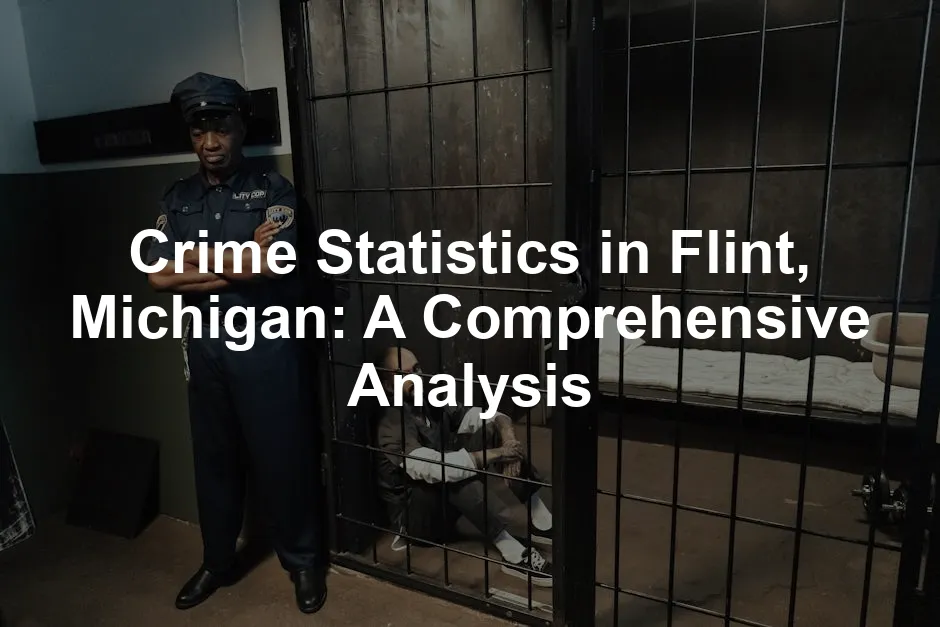Introduction
Understanding crime statistics is crucial for assessing Flint, Michigan’s safety. With a long history of crime, Flint’s reputation as one of America’s most dangerous cities is well-documented. Residents and potential movers need to grasp the realities of crime here.
Flint has consistently ranked among the top cities for violent crime. This enduring notoriety makes it essential to analyze crime data. Recent trends show fluctuations in crime rates, prompting community discussions about safety and security.
In this article, we will cover various aspects of crime statistics in Flint. We will explore historical context, current statistics, comparisons with other cities, community impacts, and potential solutions. By doing so, we aim to provide a comprehensive resource for those interested in Flint’s crime landscape.
Flint’s crime story is complex, filled with both challenges and efforts towards improvement. Understanding this landscape is vital for anyone considering living or visiting this city. With an informed perspective, we can better appreciate Flint’s ongoing journey toward safety and community resilience. If you want to dive deeper into the human experience of crime and its societal implications, consider picking up The New Jim Crow. It provides a critical look at mass incarceration and its impact on society.

Current Crime Statistics
Overall Crime Rates
Flint, Michigan, has earned a reputation as a high-crime area. The overall crime rate in Flint stands at 2,032 incidents per 100,000 people. This figure is notably higher than the state average of 2,538 and the national average of 1,998. These numbers hint at a troubling reality for residents. Violent crime rates are particularly concerning. Flint reports 985 violent crimes per 100,000 residents, which is a staggering 232.7% higher than the national average of 461.
In comparison to its peers, Flint’s murder rate is also alarming. With 13 murders recorded in 2022, the rate translates to 16 murders per 100,000 individuals. This is significantly higher than Michigan’s average of 16.2 and the national average of 6.3.
Property crime is another area where Flint struggles. The city’s property crime rate is 1,047 per 100,000 residents, slightly lower than Michigan’s 1,308 but higher than the national average of 1,537. The following chart illustrates the current crime rates, showcasing the stark differences between Flint and broader averages.
Breakdown of Violent Crimes
Violent crimes in Flint encompass several serious offenses: murder, rape, robbery, and aggravated assault. Each of these categories presents its own set of challenges. If you’re intrigued by the psychology behind crime, you might want to check out Mindhunter. It offers an inside look at the FBI’s elite serial crime unit and the minds of criminals.
- Murder: The murder rate is particularly alarming. With 13 reported homicides, Flint’s rate of 16 per 100,000 is a cause for concern.
- Rape: Reports indicate 84 cases, translating to a rate of 104.9 per 100,000 people. This figure surpasses the national average of 40.0.
- Robbery: Flint recorded 28 robberies, with a rate of 35 per 100,000, which is comparable to the national average but still indicative of significant crime.
- Aggravated Assault: Assaults dominate the violent crime statistics with a staggering 860 incidents per 100,000 people. This rate exceeds Michigan’s average of 1,074.2.
These statistics paint a daunting picture for community safety. Residents often feel the weight of these figures, leading to heightened anxiety and concern about personal safety in public spaces. For those looking for a gripping crime story, consider The Devil in the White City. It intertwines true crime with history, making for a captivating read.

Breakdown of Property Crimes
When it comes to property crimes, Flint faces challenges similar to its violent crime issues. The city sees significant incidents of burglary, theft, and motor vehicle theft.
- Burglary: The burglary rate stands at 189 per 100,000, slightly lower than Michigan’s average of 236.1.
- Theft: Theft cases dominate, with Flint reporting 689 incidents per 100,000, which is below Michigan’s 860.6. However, this still represents a considerable number of thefts that residents deal with.
- Motor Vehicle Theft: Flint’s motor vehicle theft rate is 169 per 100,000, close to Michigan’s 211.1 but substantially lower than the national average of 282.7.
Overall, the property crime rate of 1,047 per 100,000 reflects ongoing issues. While Flint’s property crime rate is lower than the state average, it remains a concern. To enhance your home security, consider investing in a Home Security Camera System. It’s an excellent way to keep an eye on your property and deter potential criminals.

Community Sentiment Regarding Crime
Community sentiment regarding crime in Flint reveals a stark divide. A survey conducted by AreaVibes shows that only 17% of residents feel secure. These individuals believe crime is virtually non-existent and feel comfortable walking the streets after dark. The remaining 83% express apprehension, perceiving a higher incidence of crime. This pervasive feeling of insecurity significantly impacts daily life and community interactions.
Moreover, the psychological toll of crime in Flint cannot be overstated. The constant fear of becoming a victim leads to heightened stress levels and affects overall mental health. The community grapples with these emotional implications, contributing to a cycle of fear and mistrust. For those interested in understanding the broader implications of crime on society, The Hate U Give offers a powerful narrative on race and justice, resonating with many of the issues seen in Flint.
In summary, Flint’s crime statistics present a complex landscape. While recent efforts may show some improvement, the data reveals ongoing challenges that residents face. Awareness and understanding of these statistics are crucial for potential newcomers and current residents alike, prompting discussions about safety and community initiatives to enhance security.

Flint’s Ranking Among U.S. Cities
Most Dangerous City Rankings
Flint, Michigan, has long held a notorious title in the crime statistics department. For over a decade, it consistently ranked among the most dangerous cities in the United States, often finding itself in the top ten for violent crime rates. Reports from various sources indicate that, from 2007 to 2009, Flint had the highest violent crime rate among cities with populations over 100,000. This alarming trend has not gone unnoticed, as residents and potential movers grapple with the implications of living in such a high-crime area.
In recent years, fluctuations in crime rates have led to discussions about Flint’s safety. While some reports suggest improvements, the overall picture remains concerning. For instance, in 2022, Flint recorded a staggering 985 violent crimes per 100,000 residents, a figure that is 232.7% higher than the national average of 461. The city’s murder rate, with 16 per 100,000 residents, is more than double the national average, further cementing its reputation as a dangerous place to live. If you’re interested in crime fiction that captures the essence of societal struggles, consider Crime and Punishment. Dostoevsky’s exploration of morality and justice is timeless.
The crime statistics don’t just serve as numbers; they reflect the reality residents face daily. Flint’s challenges are compounded by socioeconomic factors, including high poverty and unemployment rates, which often correlate with increased crime. The narrative around Flint’s crime rates emphasizes the importance of understanding these issues rather than dismissing them as mere statistics.

Comparisons with Nearby Cities
To better understand Flint’s crime issues, it’s helpful to compare its statistics with those of nearby cities like Burton, Saginaw, and Detroit. The table below provides a clear picture of how Flint measures up against these cities in terms of crime rates:
| City | Violent Crime Rate (/100k) | Property Crime Rate (/100k) | Total Crime Rate (/100k) |
|---|---|---|---|
| Flint | 985 | 1,047 | 2,032 |
| Burton | 477 | 570 | 1,047 |
| Saginaw | 1,621 | 1,681 | 3,302 |
| Detroit | 2,007 | 2,170 | 4,177 |
From the data, it’s evident that while Flint’s violent crime rate is lower than Detroit’s, it remains significantly higher than that of Burton. Saginaw, on the other hand, presents a more troubling picture, with even higher violent crime rates.
This comparison highlights Flint’s unique position in the crime landscape of Michigan. Flint’s property crime rate, while lower than the state average, still poses concerns for residents. The city’s overall crime rate of 2,032 per 100,000 people reflects ongoing issues that the community must confront. If you’re curious about the psychological aspects behind crime, The Crime Book offers insights into criminal behavior and prevention strategies.

By examining these statistics, it’s clear that crime in Flint is not an isolated problem. Instead, it’s part of a broader narrative involving socioeconomic conditions, law enforcement challenges, and community safety concerns. As Flint continues to navigate these issues, understanding its crime rates in comparison with nearby cities will be crucial for both residents and potential newcomers.

Community Initiatives and Responses
Local Government Actions
The Flint city government has ramped up efforts to tackle crime head-on. Recent initiatives focus on public safety and community engagement. One standout program is the establishment of a new cold case unit, aimed at solving long-standing unsolved crimes. Mayor Sheldon Neeley has touted this unit as a key player in driving down crime rates.
In early 2024, Flint saw a notable decline in reported violent crimes, including a jaw-dropping 40% drop in murders compared to previous years. This shift can be attributed to the city’s strategic approaches, such as collaboration with the Michigan State Police for enhanced security measures. To stay prepared for emergencies, consider a Survival Gear Emergency Kit. It’s always good to be prepared!
Moreover, the city has launched the Safe and Clean Summers initiative, which aims to engage youth in positive activities. This program not only provides jobs but also fosters a sense of community. By targeting these young individuals, the city hopes to prevent future criminal activity, creating a cycle of safety instead of one of violence.
Flint’s proactive measures are beginning to bear fruit. Community feedback reflects a growing sense of safety, even as crime rates remain a concern. The Flint Police Department has also implemented community policing strategies, encouraging officers to build relationships with residents. This approach has resulted in increased trust and cooperation between law enforcement and the community.

Community Involvement
Community organizations and local residents play a pivotal role in improving safety in Flint. Groups like the Flint Youth Coalition work tirelessly to provide educational resources and employment training for young residents. By focusing on youth engagement, these organizations aim to reduce crime by offering alternatives to illegal activities.
Programs that encourage mentorship and skill development are gaining traction. Local residents volunteer their time to guide young people towards brighter futures, fostering a sense of belonging. This grassroots approach empowers individuals to take ownership of their community’s safety. To enhance personal safety, you might consider a Personal Safety Alarm with LED Light. It’s a simple yet effective tool to have on hand.
Additionally, Flint’s residents have shown resilience and determination in addressing crime. Local forums, neighborhood watches, and advocacy groups have sprung up to ensure that voices are heard. These initiatives help bridge the gap between residents and law enforcement, creating an environment where everyone feels invested in the city’s welfare.
Community events, like clean-up days and safety workshops, further promote involvement. Residents gather to tackle issues head-on, demonstrating that Flint is more than just its crime statistics.

In conclusion, the combined efforts of the Flint city government and community organizations are crucial in the fight against crime. The focus on youth, job creation, and community engagement is paving the way for a safer Flint. While challenges remain, the unwavering commitment to change is a beacon of hope for residents and newcomers alike.
Conclusion
Flint, Michigan, has a complicated crime narrative. Throughout this article, we examined various aspects of crime statistics in the city. Flint has often been labeled one of the most dangerous cities in the United States. The numbers certainly support this reputation. With a violent crime rate that reaches 985 incidents per 100,000 residents, Flint’s statistics paint a daunting picture.
We also discussed how property crime rates, although slightly lower than the national average, remain a significant concern. Residents are particularly affected by crimes like burglary and theft, which contribute to feelings of insecurity. The community’s sentiment about safety reflects this anxiety; a staggering 83% of residents report feeling unsafe walking alone at night. If you’re interested in a gripping true crime narrative, True Crime Stories offers a compelling examination of crime and justice.
However, the future holds potential for improvement. Recent trends show a decline in crime rates, with the city reporting a notable drop in violent crimes during early 2024. Community initiatives, such as the Safe and Clean Summers program, aim to engage youth and reduce crime through positive activities. Additionally, ongoing collaboration between local law enforcement and community organizations brings hope for a safer Flint.
In conclusion, while crime statistics in Flint remain troubling, efforts are underway to foster a more secure environment. The path to improved safety requires collective action from residents, law enforcement, and local leaders. And if you’re looking for a classic that explores the human condition and morality, The Complete Works of Edgar Allan Poe is an excellent choice.

As residents of Flint, it’s crucial to stay informed about crime statistics and participate in community initiatives. Engaging with local programs can lead to a safer and more vibrant community for everyone. Understanding crime statistics is essential for making informed decisions.
FAQs
Is Flint safe to live in?
Living in Flint requires careful consideration. Although some areas may feel secure, the overall crime rates are significantly higher than national averages. This reality often leaves residents feeling anxious about safety. Community efforts aim to improve conditions, but crime remains a prevalent concern.
What are the most common crimes in Flint?
Flint struggles with both violent and property crimes. Violent offenses include murder, assault, robbery, and rape. Property crimes primarily consist of burglary, theft, and motor vehicle theft. These categories represent the most frequent types of crime affecting residents.
How does Flint’s crime rate compare to other cities?
Flint’s crime rates rank alarmingly high compared to both similar-sized cities and larger urban areas. For instance, Flint’s violent crime rate is 232.7% higher than the national average. In comparison to nearby cities, Flint often exhibits higher rates of crime, contributing to its notorious reputation.
What steps are being taken to reduce crime in Flint?
The city has launched several initiatives to combat crime. These include the establishment of a cold case unit, partnerships with the Michigan State Police, and programs aimed at engaging youth in positive activities. Community involvement is crucial in these efforts.
Where can I find more detailed crime statistics for Flint?
Residents looking for in-depth crime data can access resources from the Flint Police Department, the FBI’s Uniform Crime Reporting program, and local news sources like MLive. Websites such as AreaVibes also provide insights into crime trends and community sentiment.
Please let us know what you think about our content by leaving a comment down below!
Thank you for reading till here 🙂
For more information on safety statistics, you can check out statistics for healthcare professionals on workplace safety 2024.
All images from Pexels




